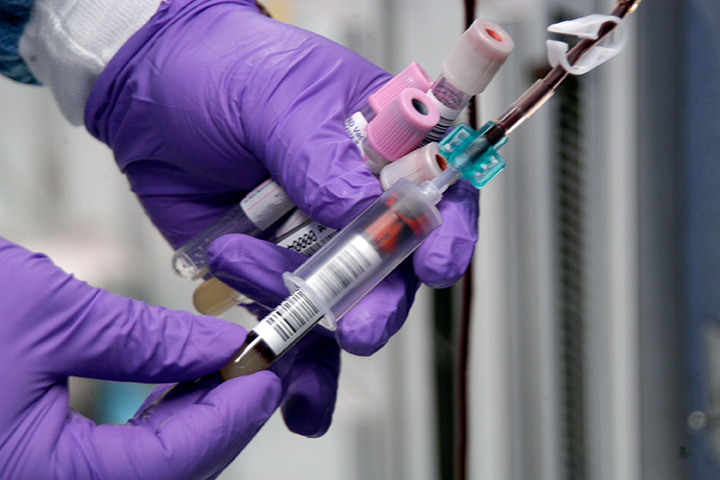Liquid Biopsies: What You Should Know

U.S. Navy
Early detection of certain cancers has proven to be an important strategy in improving outcomes and, in some instances, providing a cure for patients.
That’s why researchers are continually looking for ways to extend the promise of early detection to many different forms of cancer, including pancreatic cancer. But, as you know, pancreatic cancer is tough to diagnose at its earliest, most treatable stage. Symptoms are often vague, mimicking many different diseases. And the location of the pancreas can make it difficult to get good tissue samples with a biopsy.
In recent months, several new tests called liquid biopsies have received a lot of press due to their seeming ability to diagnose cancers, including pancreatic cancer, through a simple blood draw. Let’s Win has fielded numerous questions from our community regarding these tests and we want to provide you with what information we can.
Consider this Part One of a two-part series. In Part Two, we will interview an expert about these tests, what you should (or shouldn’t) do now, and where the research is heading. The three tests we will be discussing are dubbed IMMray™ PanCan-d test, Galleri™, and CancerSEEK. (We will be adding more.) It is important to note that IMMray™ and Galleri™ are not currently approved by the FDA and are not covered by insurance. Out-of-pocket costs are about $1,000. All tests must be ordered by a physician. CancerSEEK, which we have written about in the past, is currently not available to patients but is being actively studied.
A Quick Primer on Liquid Biopsies
Liquid biopsy tests rely on fluids. Some may examine urine; others, which are more common, look at blood samples. What scientists look for is tumor material like DNA, RNA, proteins, exosomes, and whole cells.
As an example, there is a lot of ongoing liquid biopsy research that analyzes tumor DNA in blood called circulating tumor DNA (ctDNA). When cancer cells go through their life cycle and eventually die, fragments of their DNA can enter the bloodstream. So ctDNA testing examines a patient’s blood to detect these DNA fragments from cancer cells.
Liquid biopsy technology is still new, but the information found in the blood through these tests does hold promise. A liquid biopsy could potentially find a tumor before it is big enough to be seen on imaging or even before a patient experiences symptoms. Suspect lesions, some of which might be in parts of the body that are tough or potentially dangerous to access with a scalpel or even a needle, could potentially be discovered through a blood draw. Since some liquid biopsies are designed to find multiple cancers, they could become a kind of screening mechanism for cancers that don’t have traditional screening—which is the majority of cancers. A liquid biopsy could even determine where a cancer is originating and what kind of treatment might be best used to eradicate it.
Remember: We aren’t there yet. More research needs to be done. None of these tests replace current screening recommendations and diagnostics. And all should be discussed with your medical team.
The Tests
Pancreatic Cancer Specific: IMMray™ PanCan-d test (Immunovia, Inc.)
Target Population: Intended only for adults who are at high risk for developing familial or hereditary pancreatic cancer. The company emphasizes this is not a screening test for pancreatic cancer. Since the disease has a relatively low incidence, screening of the general population would result in an abundance of false-positive results. A physician order is necessary.
How It Works: Through a blood draw, levels of nine serum biomarkers, including CA 19-9, a well-established marker of pancreatic and other cancers, are assessed using an algorithm designed to detect pancreatic cancer. According to Immunovia, the test relies on the IMMray™ microarray technology, where single chain fragment antibodies are printed onto a slide in a measured amount as a microarray of different antibody biomarkers. The microarray is scanned using a fluorescence scanner to measure the serum response to each biomarker. A separate CA 19-9 test is performed. The values for each biomarker (including CA19-9) are then entered into proprietary computer software, which uses an algorithm to determine a result of High-Risk Signature Present, Negative for High-Risk Signature, or Borderline.
Results: Sent to referring physician in about five to seven business days
- Cost: $995
- FDA approved—no
Research: Data from a blinded validation study demonstrated that Immunovia’s IMMray™ PanCan-d biomarker signature and CA 19-9 test effectively detected pancreatic cancer. The test detects early stage I and II pancreatic cancers with a test specificity/sensitivity of 98%/85% vs. familial/hereditary controls and with a specificity/sensitivity of 99%/85% vs. healthy controls. All stages of pancreatic adenocarcinoma were detected with a specificity of 98% and a sensitivity of 87% against familial/hereditary controls. Trials are ongoing.
Who Is Considered High-Risk? Pancreatic cancer risk is higher in those whose parents, siblings, or children developed the disease, particularly at a young age, and in those who have any of 10 genetic mutations, including mutations in the BRCA1/2 gene, among others. Click here to learn more about high-risk and pancreatic cancer.
Multi-Cancer Test: Galleri™ (GRAIL)
Target Population: Recommended for use in adults with an elevated risk for cancer, such as those aged 50 or older. The Galleri™ test does not detect all cancers and should be used in addition to routine cancer screening tests recommended by a healthcare provider. Galleri™ is intended to detect cancer signals and predict where in the body the cancer signal is located. Use of Galleri™ is not recommended in individuals who are pregnant, 21 years old or younger, or undergoing active cancer treatment. A physician order is necessary.
How It Works: The test looks for DNA found in the blood, called cell-free DNA (cfDNA), that’s shed by both tumor cells and healthy cells into the bloodstream. In order to detect only cfDNA that indicates the presence of cancer, Galleri™ uses genetic sequencing technology and artificial intelligence to scan for patterns of chemical changes in the cfDNA that come from cancer cells but aren’t found in healthy cells. Galleri™ results can point to where in the body the cancer is coming from, to help your healthcare provider guide next steps. If the test indicates “Signal Detected,” it means there is a suspicion of cancer. However, this is not a diagnosis of cancer. Appropriate follow-up will be determined by a physician. A result of “Signal Not Detected” means that no cancer signal was found. But not all cancers can be detected by the Galleri™ test. Continue with all routine screening tests that your healthcare provider recommends.
Results: Available to your healthcare provider within 10 business days
- Cost: $949
- FDA approved—no
Research: Trials are ongoing, and research showed the test had 76.3% sensitivity in a large number of cancers that cause two-thirds of cancer deaths in the United States. Researchers at the Mayo Clinic used the Galleri™ test in the Circulating Cell-free Genome Atlas Study (CCGA), a prospective, observational, longitudinal study designed to characterize the landscape of genomic cancer signals in the blood of people with and without cancer. In the study, the Galleri™ test demonstrated the ability to detect more than 50 types of cancers—over 45 of which have no recommended screening tests. National Health Service England is undertaking a Galleri™ study that will include 140,000 people. Participants will predominantly be 50-77 years old with no symptoms who will take annual blood tests. If the pilot proves successful, it will be expanded to one million participants in 2024 and 2025. Another ongoing study is the large, prospective, multicenter PATHFINDER, with approximately 6,200 participants.
Multi-Cancer Test: CancerSEEK (Thrive)
Target Population: CancerSEEK is currently in development and is not yet available to patients. Information about enrolling in upcoming clinical trials will be provided in the future. The FDA has designated CancerSEEK as a Breakthrough Device, due to its lifesaving potential. CancerSEEK looks for cancer-specific mutations on 16 genes and for eight proteins that are linked to cancer and for which there are highly sensitive tests.
Research: A large, prospective, interventional study conducted by researchers at Johns Hopkins and Geisinger called DETECT-A showed the blood test identified cancers in individuals without any history of the disease and more than doubled the number of cancers that were first “screen-detected.” Twenty-five percent of the women who were diagnosed with cancer were identified by current standard-of-care tests. By incorporating the blood test, the percentage of “screen-detected” cancers increased from 25% to 52%. It identified cancers across 10 different organs, seven of which currently have no standard-of-care screening; 65% of the cancers identified were localized or regional. In combination with imaging, the test minimized false positive results with 99.6% specificity. The trial enrolled more than 10,000 women with no prior history of cancer and evaluated a version of CancerSEEK that was first developed in 2016. Since then the test has undergone some changes.





